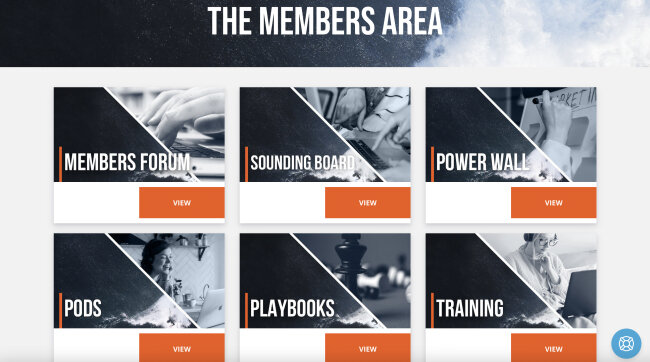Podcast: Download (Duration: 35:52 — 33.6MB)
Get Notified Of Future Episodes Apple Podcasts | Spotify | Amazon Music | Android | Blubrry | Gaana | TuneIn | Deezer | Anghami | RSS | More
When a membership is fairly established, a platform migration can be quite the challenge. James invites KLEQ’s John Lint to help him share how his membership transfer is going.
They discuss the process of decluttering when moving to a new membership platform.
James talks about the things people look for with membership portals.
And he gives reasons why he decided Kleq was the best online membership platform for his and his members’ needs.
Table of contents
1. A process of declutter
2. The questions that need answering
3. A new system for things
4. You can’t do everything for everyone
5. Deciding what to do and what not to do
6. How the migration is progressing
7. What is and isn’t there
8. The coaching element
9. Other parts of the plan
10. There’s a lot to say for starting fresh
11. The possibilities at your disposal
12. A lot to be excited about
A process of declutter
Before the migration, James’s membership included a forum, a separate cart, and a separate communication chat bubble setup, and was hooked up with email systems and a hosting solution that cost a fortune. And it contained many, many years of content.
James has gone through three or four platforms since 2009, and up till now was able to migrate all the old stuff into the new solution. This time, he couldn’t.
Sunk cost used to keep him from starting fresh. But this time around, his core members, the intermediate to high-level players, are at a place where they don’t need as much content.
What they do need is James, and contact with each other. That connection is important.
So what James is looking at is the equivalent of moving into a new facility, versus renovating. It involves declutter and purging – a big job, but James has his team and John helping.
The questions that need answering
Given that they’re basically moving, as James puts it, from a six-bedroom home to a two-bedroom unit, the pressing questions are:
What do they take?
What’s worth James’s time?
What do they let go?
A new system for things
James explains, for clarity, how things are set up.
On the old platform, his membership was forum-based, and he was loading his products into the forum. He’d also hacked the forum over the years to have a dashboard, and a private section where he could coach people.
It was John’s observation that James was using the forum differently from how it was intended. And James got that, but didn’t know how else he could manage his information products.
Kleq solved that. James can now have a portal for his products, and a forum.
The forum is essential, James thinks. As much as people love social media, they still need a walled-off safe space where they can have great discussions.
So splitting the forum off from the products and into further sections, James now has four sections, or three, depending on membership level. Open to the public now, there are two levels.
You can’t do everything for everyone
The first, quite affordable level, is Connect, at sub $100 USD a month. Members there get the forum, which grows over time.
And what James has done is replicated on the new platform only the most popular forum sections.
When people come in and ask for a section that isn’t there, James will consider: is that valid, knowing what he knows? Is it actually what they want, or do they not even know what they want?
As the technology developer, John is faced with this as well. And John doesn’t believe in bending to everyone’s will; rather, he says, it’s very important to keep in mind the vision, what is your vision as the owner, where do I want to go?
In James’s case, he’s aiming to keep things simple, and much more focused on discussion. So the question is, what will respect that vision and make most people happy?
Inevitably, you can’t please everyone.
Deciding what to do and what not to do
Totally on point, says James. And when people come asking for things that the platform doesn’t currently do, he brings them up with John.
James realizes, of course, that a lot of it is comfort. We get comfortable with the way things work.
So he asks John the pertinent questions: Do we actually even want that? Is that useful for anyone else except for this person?
Instances like that aside, though, James has already had good feedback from test users. The usability and layout, they say, is light years ahead of the previous iteration.
And sometimes a feature request makes practical sense, and John adds it to the platform. Or it might be too technical or just not practical, and they bin it.
How the migration is progressing
At time of recording, James has dozens of members putting the new setup through its paces. And his team are getting more involved and active; there’s a lot happening.
They’ve set up some carts, and are bringing some members into the new membership directly.
The legacy members have access to both memberships, while James and his team decide what to bring across.
And when James’s team do bring something across, they turn off the thread in the old membership, informing people it’s now on the new platform. This keeps people from adding to the old forum.
What is and isn’t there
James now basically wants the most up to date, present community possible to help him serve. He wants maximum impact for his clients.
So members still have the forum, where James has put the very best, most popular topics. What’s gone is the concertina of topics that weighed things down.
The second feature Connect members have access to are Playbooks. These are actionable frameworks and checklists, based on James’s personal life sheet, content from SilverCircle and SuperFastBusiness, training summaries, and long-developed threads of value from the old community.
This content has been condensed into playbooks that people can follow like a recipe and get repeatable results.
And under each playbook is a comment section where people can say what they think, or ask questions.
For content-obsessed Connect members, there’s more. The training section of the membership contains 70 or 80 trainings – all the trainings from the old community are there; all the event recordings; and when James records a new training each month, it goes in there.
James’s goal is to someday go through the old trainings, make a playbook from each, and then delete the old training.
For a details guy like John, the trainings are quite valuable. Should you struggle, say, with a framework, you can refer to the training for a more in-depth discussion – they’re complementary to the playbooks, John thinks.
And the stuff the membership delivers – community, shortcuts, events, live Q&A – that’s all a member needs, really, says John.
The coaching element
That’s it, says James, except, if you’e a Mentor member, you get the sounding board. This is an alternative to the word “coach”, which James doesn’t love for some reason.
James likes to have clients, to be a partner, and most of all mentoring people. And a mentor, to some extent, needs actual experience.
So he asks his highest level members and his partners what he brings to the table. And they tell him he’s the person they can have a proper conversation with about their business, who understands what they’re talking about and can offer perspectives or give them confidence – the sounding board they need.
And all of this is customized and in perfect confidence. James listens, and matches up people with what he knows, giving them appropriate suggestions and guidance.
Via the sounding board feature, Mentor members get an invite to weekly group calls, and a chat button. And it works on the phone – they can leave messages that James answers.
The sounding board accepts images, and James can embed Loom videos – it gives him everything he needed from the private coaching before, but now as its own product.
This is the level James’s partners are on, with his old SilverCircle members and what used to be called Intensive members.
In short, there are only four boxes when you log into the new membership: Members’ forum, Sounding Board, Playbooks and Training.

Members Area in Kleq (Note, at time of podcast release, there are two additional options, Pods and Power Wall)
Other parts of the plan
In terms of other things that James and his team are doing, James does have a migration plan.
They’ve taken an inventory of all the tools they use, and then plan to sunset them or make them obsolete. So they’re getting rid of Intercom, and the old cart switches over to the cart that’s in Kleq – they want people to be tied to the platform with the cart, eventually, because if they stop paying, then they stop getting access, and they want to rejoin; It’s all linked.
And you get your data, the reporting, all of that, says John.
James wants that. And he wants the sales pathway. So he’ll put the new page on Kleq as well, so he can log into the dashboard and see how many people visited the page, how many people became members, all that information.
They’re literally going out one by one and telling people, We’ve added you to the new community. And when there’s a billing event, if they’re annual, they’ll bring them across to the new cart; if they’re changing their credit card, they’ll bring them across to the new cart.
Eventually, they might have more of a bulk event, say, Hey, we’re moving to the new cart. Could you go over here and rejoin? And then stop the old subscription.
Probably not worth it, though, says James – the loss of members in that event would be substantial, he suspects. Because people might ask, Oh, do I really need this?
So they’re doing things gradually.
James is basically doing a new sales offer, because he feels like the new offer is more about the Sounding Board and the Playbooks than the old offer, which was a lot about the content. He’s tuning the words on the page, making it simpler and easier to understand – like every aspect of the migration, the usability is strong.
As they bring people across, they communicate with them, all the way through. They’ll basically have access to both memberships, and then over time, they’re bringing the stuff across and closing down the old setup.
Then there will be a period when everyone’s in, and they’ll be turning off the old membership. This is when people had better get what they need from the old place before they lose access.
After that, they can tell James and he’ll get it – there’ll be an archived version on a low server speed.
There’s a lot to say for starting fresh
James has changed names before, and switched channels, and sold businesses. But this process is the most difficult, because he has over a decades’s worth of stuff, and has to make choices.
It’s not comfortable, but James is excited about the opportunity to start fresh. Starting fresh is underrated.
The inability for James to just push a button and import everything into Kleq is a blessing – it’s keeping the environment clean. Importing everything would inevitably bring junk, bits and pieces no one needs or wants.
James just had a call with a lady in the early stages of her business. She’s not tech-savvy, doesn’t really know how to drive traffic.
But she already has clients, for a one-time, six-week product. What do I do now, she asks?
Do the people in the six week product want to stay, asks James?
They do.
Then go to Kleq.com, James suggests. Join, get access to the software, follow the templates on the sales page, put an amount you want to sell for a monthly membership, create a members’ community. And then you’re in business, like tomorrow.
For someone in the early stages, it’s easier – they’re starting clean.
Just follow the training, says John. If you have questions, show up to his weekly calls.
John and his team aim to make it as easy as possible for people to set up what they need, whether a blog, a website, sales funnels, a shopping cart, or a members’ area like a forum.
You can have private groups or social walls; private coaching like James does, or content and courses. And when it’s all done, you can focus on attracting people by publishing good content, like an online business should.
The possibilities at your disposal
The coolest thing, says James, is Kleq offers a slew of features, just a fraction of which James uses now, but many of which he can use later.
He’s excited to reach the point where he can turn on a book funnel, or do an on-demand training, use some of the many boosters.
The automation, says John, the segmentation stuff.
James was thinking: why not make two versions of his new sales page, and use the split testing feature? But at the moment, he’s thrashing John with requests for things he doesn’t have.
A red love heart, for instance. It was blue, but John pushed a new code to the platform just to make it red, for James.
A lot to be excited about
James is the most excited he’s ever been in his online journey. It’s like a new beginning.
He’s starting fresh with all the stuff he knows, but with the same customers and all the information. And now they’re doing it right.
And John is continuing to build Kleq to do what people like James and he himself need it to do.
It’s an incredible platform, says James, with a lot of thought put into it.
Join like-minded business owners inside the James Schramko membership
Enjoyed the show? Leave us a review on iTunes












Leave a Reply